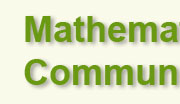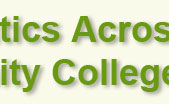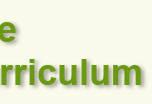|
MAC3 and Mathematics
Modeling Atmospheric CO2 Data
The buildup of carbon dioxide in Earth’s atmosphere as a result of human industrial and agricultural activities is amplifying the planet’s natural greenhouse effect and producing global climate change. Data on global atmospheric CO2 has been collected since 1958 when Charles Keeling began sampling and recording the data from the Mauna Loa Observatory in Hawaii. The data show a variety of cyclical features, but the most profound is the consistent rise in concentrations. From a mathematical point of view, the question arises as to how well the data can be matched to a particular function. From both a mathematical and a scientific point of view, regression analysis of the data could suggest how the future of CO2 concentrations may appear. In this activity, students will use actual CO2 data from the Mauna Loa Observatory in Hawaii to create their own “Keeling Curve”; conduct an analysis of the data; and, attempt to match it to a mathematical function. They will then use the function to predict increases in CO2, both historical and future.
Developing a Transportation Survey to Estimate Gasoline Use by Campus Commuters
Through this activity, students in a liberal arts mathematics class will develop experience with real-world statistical concepts through the context of sustainability: estimation, survey writing, sampling techniques, and data analysis.
Foundations of Elementary Mathematics
This project deems to create inter-disciplinary program to create cultural diversity in classrooms by combining art and math. As well to create interactive class projects to encourage students’ interests in academic pursuit. Finally it will offer students broader aspects of the discipline to achieve higher understanding.
Math and Reading - Creating Synergy
This course will cover interesting themes such as health and wellness, global and environmental awareness, minority issues, civic duties, and budgeting.
Preparing EAP (ESL) Students for College Success by Integrating Math Concepts in the EAP Curriculum
This project is set up to help ESL students succeed in their college career by building connections between math and language instruction. Instructors can help “bridge gaps in literacy students’ math knowledge, expand their communicative competence in English, and ultimately prepare them for success in future math coursework.
Using Art History To Lower Math Anxiety
Use the history of the development of the pyramidal construction form in Egyptian architecture to explain to the students how these forms evolved utilizing both mathematics and geometry to achieve the perfect pyramid.
Communicating Computations: Basic Writing Skills and Developmental Mathematics
Students will develop tolerance for diversity by exposure to diversity issues in the media, students will see the importance of written expression within the Math context, students will conquer their Math and Writing anxieties, students will be engaged, students will publish their writing samples.
Political Science, Math and Speech
To graduate
with honors, students in the Honors Program are required to take one
interdisciplinary seminar. A new IDS course to be offered in the
Fall of 2008 will examine the presidential election. One of the
units will focus on the Electoral College method of selecting the
president and alternative plans that have been suggested. Students
will be divided into groups and be given a set of data that includes
results from four previous presidential elections, two elections that
were quite close and two that were just the opposite. In addition to
calculating the winner of these elections under each of four
alternative plans, the students will also conduct statistical
analyses to aid in their understanding of the implications of using
each plan.
Arrested Development: Investigations and Math
At the end of this course students should be able to: Use general problem solving skills, use deductive reasoning, read and interpret graphs, solve linear equations, use mathematical models to help make decisions.
TEEMS (Technology for Educators for Math & Science
With this project, the Ed Media students will prepare a science and math combination lesson plan that uses new and existing technology in math and science. After developing the plan, the students will teach the lesson to the class.
Percents, Formulas, and the Culinary Arts
To show the algebraic and mental approach to
solving percent related questions in applied
situations for culinary students. To show the techniques for solving ‘on the job’
formulas for culinary students
Empowering Math in Physics
Linear Equations, Quadratic Equations, Systems of linear equations, Vectors, Trigonometry.
Figuring Out our Next President
Mathematics & Psychology. The College Learning Outcomes allow students to develop lifelong skills in each of the following ten areas:
- Communication
- Quantitative Analysis
- Critical/Creative Thinking and Scientific Reasoning
- Information Literacy
- Global, Cultural, and Historical Perspectives
- Personal, Civic, and Social Responsibility
- Ethical Thinking
- Computer and Technology Usage
- Aesthetic Appreciation
- Natural Systems and the Environment
Dive Right in to Algebra and Physics
This course is designed to develop an understanding of the phenomena of our everyday life via the laws of physics. The emphasis is not on problem-solving, although this aspect will be addressed, but on encouraging students to understand and appreciate their environment from a new perspective. The course may include topics in measurement, mechanics (motion, forces, momentum, energy, gravity and the planets) and other physics subfields such as fluid and thermal physics, electrical and magnetic phenomena, wave motion and optics, atomic and nuclear physics. GSCI 104 satisfies science general education requirements.
Powerful Outcomes: Math as the Language of Physics
An enhanced experience for students taking both courses either at different times or during the same semester. The overall goal of the LC is to further the unde4rstanding of physics with improved math skills and make mathematics more meaningful with physics applications.
Math and Finance
Students will be able to:Understand how the same financial terms and
concepts are used at home, school and work. Calculate return on investment. Calculate ultimate cost of debt. Develop a budget. Forecast finances using financial statements.
Math in the Workplace
- Revise Problem Solving Module
- Design Process to Identify and Serve Vocational Education Students
- Develop Hybrid Course targeting Auto Technology, Business Administration and Culinary Arts Programs
Teaming Social Research and Statistics
Students will be able to:State an operational definition of their research topic, select research method (survey, experiment),formulate a hypothesis, gather data using sound sampling methods, compile and analyze data (hypothesis testing), form valid statistically significant conclusions, display results for a general audience.
Organisms, Mathematics, and the Environment
This course will focus on the basic concepts of ecology, including ecosystem structure and function, energy flow, biochemical cycles, limiting factors, population dynamics and community interactions. Emphasis is placed on the use of the scientific method to investigate man's current environmental problems and to propose possible solutions. Meets A.A. degree lab science requirement.
Math + English = 4Words
Weekly math-themed story problems, introduces different writing styles, encourages creativity and problem solving, make connections between math and English, better strategies make better communicators.
Making Connections
This course is a learning community that includes a 10-credit coordinated studies class that combines English 81 and Reading 94 with a link to Math 62. Not all students in the coordinated studies class (capped at 48) will be in the math class (capped at 32), but we are hoping that all of the math students will be in the coordinated studies course.
Communicating in Numbers and Words
In this fully-integrated, team-taught course, students will focus on
recognizing and using patterns and attending to details in English and
Math. Assignments throughout the course will tie both subjects
together.
Going With the Flow: Stream Statistics
The faculty created a module that incorporates statistics and
geoscience into a liberal arts math course. This module will be used
later in geoscience courses and in a linked math and geoscience course.
Math for Elementary Teachers II : Inquiry into Life Science
This four-class learning community will provide an integrated curriculum experience for the final semester of elementary education majors focusing on integrating math into the science and education curricula.
General Education Biology College Algebra Learning Community
This learning community course links General Education Biology (BSC1005) and College Algebra (MAC1105) at Miami Dade College.
Integrating Science and Math for Elementary Education Majors
The faculty developed modules for implementing into the Science and Math Courses for Elementary Education Majors. The modules included topics including ratios of surface area and volume, the Normal distribution, data analysis, and probability.
Vectors
This project addresses a mathematics and physics instructional discontinuity at Butler Community College.
Beginnings: A Learning Community
Beginnings is a learning community that integrates reading, English, and math curriculum at the preparatory level. Our goal is to enhance student achievement and learning to prepare students for college level courses, career and technical programs, and the workplace.
Inquiry Into Life Science and Math for Elementary Teachers II
This project aims to revise assignments and the associated rubrics to incorporate more quantitative reasoning into Biology and Mathematics courses for Elementary Teachers. The theme of the course is "So what…” and encourages students to think about the big questions of what is the meaning, what are the trends, and what are the consequences and limitations of the data collected.
Math, Geology, and Economics
In this project the faculty created modules that will be used in a selected mathematics course (College Algebra) and in applied content courses of General Geology and Economics. The modules make use of three representations of relations, namely data tables, graphs, and formulas.
Math and and Human Development
Design a coordinated studies course that consists of Math 099 (Intermediate Algebra) and Human Development (HD) 120 (Learning Strategies for Student Success). This course consists of 8 credits (5 for Math 099 and 3 for HD-120). It is anticipated that thirty to thirty-five students from two Math 099 sections will enroll in the HD-120 section. A typical section of HD-120 does not focus specifically on learning strategies for math courses. However, a special effort will be made to focus the HD-120 learning strategies in support of the Math 099 sections.
A Navigation Unit for Linked Mathematics and Earth Science Classes
The project created navigation modules including instruction on using GPS technology and UTM coordinates. The goal is to provide life-saving information to students while incorporating necessary core curriculum from both mathematics and Earth science classes. They used field-based activities, as well as assessments, to insure that students who complete the course are prepared to safely enjoy the outdoors and are prepared for any courses requiring mathematical problem-solving and/or lab science as a prerequisite.
A Learning Community of College-Prep Mathematics and Student Life Skills
This course integrates arithmetic and beginning algebra with the " Preparing for Student Success" course
. The mathematical topics include addition, subtraction, multiplication, and division of whole numbers, fractions, decimals, and their applications; percents and applications; measurement of perimeter and area of plane figures and volumes of solids; operations on signed numbers; solving linear equations in one variable; operations on polynomials; factoring; integer exponents; radicals; graphing; simplifying algebraic fractions; applications of these topics. In addition, this learning community will attempt to decrease students' math anxiety through exercises and activities.
Quantitative Reasoning and Experiential Psychology:
This MAC course is an applied psychology course which emphasizes the understanding of the principles of effective human behavior and their application to the areas of personal awareness, interpersonal relations, communication, and work/career development.
The students will learn the mathematical concepts necessary for understanding for individual assessment and impact, absolute risk and relative risk, and the Pearson Product Moment Correlation and Association.
Environmental Awareness through Mathematical Modeling
Students develop mathematical literacy and environmental awareness as they model natural processes using algebraic, graphical, and numerical methods, and analyze data quantitatively to assist in objective decision making. Collaborative projects are incorporated into each part: (1) Basic Numeracy; (2) Function Modeling; (3) Difference Equation Modeling.
Math and Criminal Justice
With the recent explosion of crime dramas on television, such as CSI, Law and Order, 24, Numb3rs, etc., our proposal centers on integrating one or two sections of our Math for Liberal Arts class with the new Criminal Justice program, beginning Fall 2007.
Linking Basic Algebra, Basic Reading, and Basic Writing:
This project develops the curriculum materials for a learning community that links the courses Basic Algebra I, Basic Reading, and Basic Writing. The theme for the learning community is real world applications and the name Alpha is used to advertise and register students. One of the main objectives is to help students develop projects that apply skills and concepts from all three of our courses to different global issues.
The Wizard of Oz - Education & Math Together:
- Develop/re-establish confidence in one’s mathematic skills.
- Educating prospective teachers in projecting a positive image of mathematics in the elementary school classroom.
- Address the critical shortage needs for mathematics teachers/specialists, focusing on the elementary school grades.
- Understanding teaching & learning issues unique to our shared subjects.
- Assess student learning by various means including portfolios, classroom presentations, group projects, and traditional methods.
- Ensure Global Learning Outcomes are addressed/incorporated in both courses
Intermediate Algebra:
Creating a two-quarter option for Intermediate Algebra at Edmonds Community College. The two-quarter sequence will emphasize applications of the mathematics as well as study skills and group work.
Business Calculus at University of Washington (2002-2003):
Curriculum designed for active learning and making connections in the Business Calculus two-quarter sequence.
|









